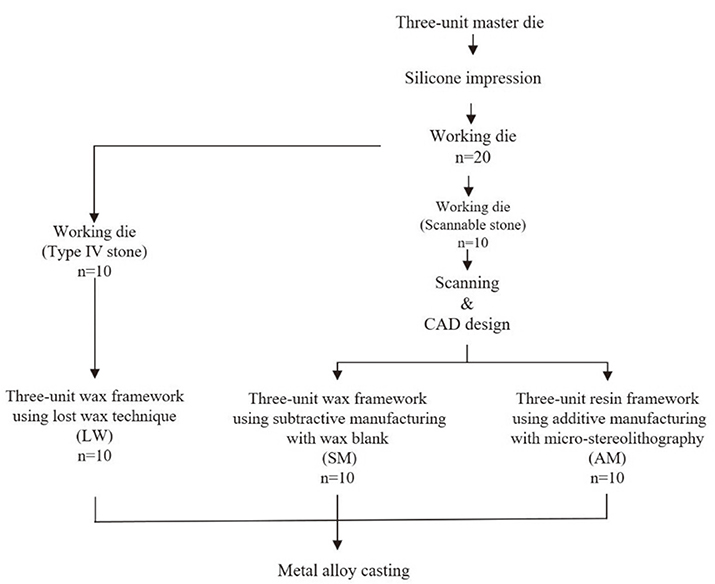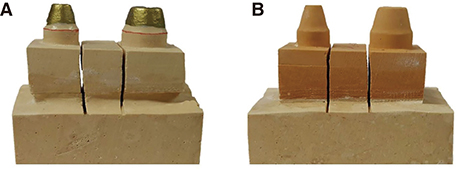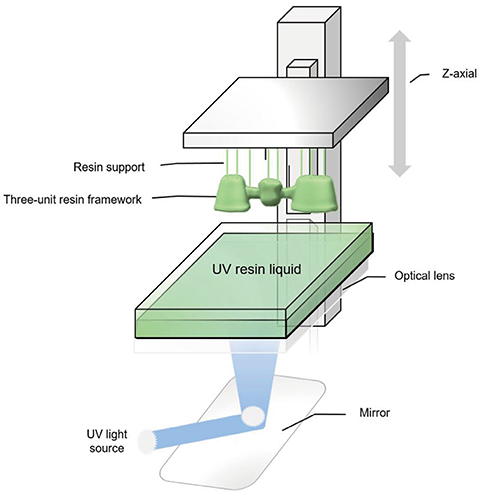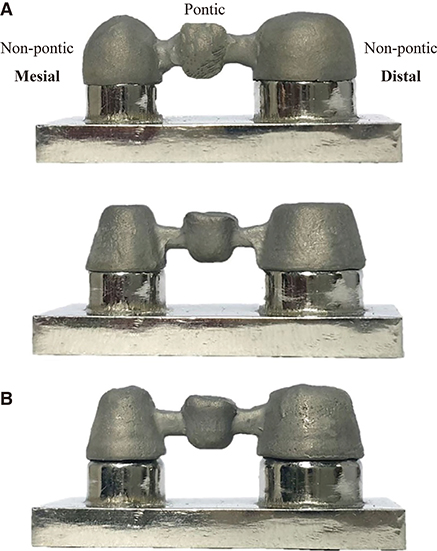J Adv Prosthodont.
2017 Dec;9(6):463-469. 10.4047/jap.2017.9.6.463.
Evaluation of marginal and internal gap of three-unit metal framework according to subtractive manufacturing and additive manufacturing of CAD/CAM systems
- Affiliations
-
- 1Department of Dental Laboratory Science and Engineering, College of Health Science, Korea University, Seoul, Republic of Korea. kuc2842@korea.ac.kr
- 2Department of Public Health Sciences, Graduate School & BK21+ Program in Public Health Sciences, Korea University, Seoul, Republic of Korea.
- KMID: 2398051
- DOI: http://doi.org/10.4047/jap.2017.9.6.463
Abstract
- PURPOSE
To evaluate the fit of a three-unit metal framework of fixed dental prostheses made by subtractive and additive manufacturing.
MATERIALS AND METHODS
One master model of metal was fabricated. Twenty silicone impressions were made on the master die, working die of 10 poured with Type 4 stone, and working die of 10 made of scannable stone. Ten three-unit wax frameworks were fabricated by wax-up from Type IV working die. Stereolithography files of 10 three-unit frameworks were obtained using a model scanner and three-dimensional design software on a scannable working die. The three-unit wax framework was fabricated using subtractive manufacturing (SM) by applying the prepared stereolithography file, and the resin framework was fabricated by additive manufacturing (AM); both used metal alloy castings for metal frameworks. Marginal and internal gap were measured using silicone replica technique and digital microscope. Measurement data were analyzed by Kruskal-Wallis H test and Mann-Whitney U-test (α=.05).
RESULTS
The lowest and highest gaps between premolar and molar margins were in the SM group and the AM group, respectively. There was a statistically significant difference in the marginal gap among the 3 groups (P < .001). In the marginal area where pontic was present, the largest gap was 149.39 ± 42.30 µm in the AM group, and the lowest gap was 24.40 ± 11.92 µm in the SM group.
CONCLUSION
Three-unit metal frameworks made by subtractive manufacturing are clinically applicable. However, additive manufacturing requires more research to be applied clinically.
MeSH Terms
Figure
Cited by 2 articles
-
Comparative clinical study of the marginal discrepancy of fixed dental prosthesis fabricated by the milling-sintering method using a presintered alloy
Mijoo Kim, Jaewon Kim, Hang-Nga Mai, Tae-Yub Kwon, Yong-Do Choi, Cheong-Hee Lee, Du-Hyeong Lee
J Adv Prosthodont. 2019;11(5):280-285. doi: 10.4047/jap.2019.11.5.280.Evaluation of the reproducibility of various abutments using a blue light model scanner
Dong-Yeon Kim, Kyung-Eun Lee, Jin-Hun Jeon, Ji-Hwan Kim, Woong-Chul Kim
J Adv Prosthodont. 2018;10(4):328-334. doi: 10.4047/jap.2018.10.4.328.
Reference
-
1. Ucar Y, Akova T, Akyil MS, Brantley WA. Internal fit evaluation of crowns prepared using a new dental crown fabrication technique: laser-sintered Co-Cr crowns. J Prosthet Dent. 2009; 102:253–259.2. Beschnidt SM, Strub JR. Evaluation of the marginal accuracy of different all-ceramic crown systems after simulation in the artificial mouth. J Oral Rehabil. 1999; 26:582–593.3. Christensen GJ. Choosing an all-ceramic restorative material: porcelain-fused-to-metal or zirconia-based? J Am Dent Assoc. 2007; 138:662–665.4. Gorman CM, Ray NJ, Burke FM. The effect of endodontic access on all-ceramic crowns: A systematic review of in vitro studies. J Dent. 2016; 53:22–29.5. Ferrari M, Giovannetti A, Carrabba M, Bonadeo G, Rengo C, Monticelli F, Vichi A. Fracture resistance of three porcelain-layered CAD/CAM zirconia frame designs. Dent Mater. 2014; 30:e163–e168.6. Bindl A, Mörmann WH. Marginal and internal fit of all-ceramic CAD/CAM crown-copings on chamfer preparations. J Oral Rehabil. 2005; 32:441–447.7. Quante K, Ludwig K, Kern M. Marginal and internal fit of metal-ceramic crowns fabricated with a new laser melting technology. Dent Mater. 2008; 24:1311–1315.8. Park JY, Kim HY, Kim JH, Kim JH, Kim WC. Comparison of prosthetic models produced by traditional and additive manufacturing methods. J Adv Prosthodont. 2015; 7:294–302.9. Pradíes G, Zarauz C, Valverde A, Ferreiroa A, Martínez-Rus F. Clinical evaluation comparing the fit of all-ceramic crowns obtained from silicone and digital intraoral impressions based on wavefront sampling technology. J Dent. 2015; 43:201–208.10. Sarrett DC. Prediction of clinical outcomes of a restoration based on in vivo marginal quality evaluation. J Adhes Dent. 2007; 9:117–120.11. Seo D, Yi Y, Roh B. The effect of preparation designs on the marginal and internal gaps in Cerec3 partial ceramic crowns. J Dent. 2009; 37:374–382.12. Fransson B, Oilo G, Gjeitanger R. The fit of metal-ceramic crowns, a clinical study. Dent Mater. 1985; 1:197–199.13. McLean JW, von Fraunhofer JA. The estimation of cement film thickness by an in vivo technique. Br Dent J. 1971; 131:107–111.14. Kim CM, Kim SR, Kim JH, Kim HY, Kim WC. Trueness of milled prostheses according to number of ball-end mill burs. J Prosthet Dent. 2016; 115:624–629.15. Baba NZ. Materials and processes for CAD/CAM complete denture fabrication. Curr Oral Health Rep. 2016; 33:203–208.16. Kim DY, Jeon JH, Kim JH, Kim HY, Kim WC. Reproducibility of different arrangement of resin copings by dental microstereolithography: Evaluating the marginal discrepancy of resin copings. J Prosthet Dent. 2017; 117:260–265.17. van Noort R. The future of dental devices is digital. Dent Mater. 2012; 28:3–12.18. Wong KV, Hernandez A. A review of additive manufacturing. ISRN Mech Eng. 2012; 06. 17. DOI: 10.5402/2012/208760.19. Örtorp A, Jönsson D, Mouhsen A, Vult von Steyern P. The fit of cobalt-chromium three-unit fixed dental prostheses fabricated with four different techniques: a comparative in vitro study. Dent Mater. 2011; 27:356–363.20. Holmes JR, Bayne SC, Holland GA, Sulik WD. Considerations in measurement of marginal fit. J Prosthet Dent. 1989; 62:405–408.21. Holmes JR, Pilcher ES, Rivers JA, Stewart RM. Marginal fit of electroformed ceramometal crowns. J Prosthodont. 1996; 5:111–114.22. Beuer F, Aggstaller H, Edelhoff D, Gernet W, Sorensen J. Marginal and internal fits of fixed dental prostheses zirconia retainers. Dent Mater. 2009; 25:94–102.23. Laurent M, Scheer P, Dejou J, Laborde G. Clinical evaluation of the marginal fit of cast crowns-validation of the silicone replica method. J Oral Rehabil. 2008; 35:116–122.24. Molin M, Karlsson S. The fit of gold inlays and three ceramic inlay systems. A clinical and in vitro study. Acta Odontol Scand. 1993; 51:201–206.25. Neves FD, Prado CJ, Prudente MS, Carneiro TA, Zancopé K, Davi LR, Mendonça G, Cooper LF, Soares CJ. Microcomputed tomography evaluation of marginal fit of lithium disilicate crowns fabricated by using chairside CAD/CAM systems or the heat-pressing technique. J Prosthet Dent. 2014; 112:1134–1140.26. Pelekanos S, Koumanou M, Koutayas SO, Zinelis S, Eliades G. Micro-CT evaluation of the marginal fit of different In-Ceram alumina copings. Eur J Esthet Dent. 2009; 4:278–292.27. Kim KB, Kim JH, Kim WC, Kim JH. Three-dimensional evaluation of gaps associated with fixed dental prostheses fabricated with new technologies. J Prosthet Dent. 2014; 112:1432–1436.28. Berger U. Aspects of accuracy and precision in the additive manufacturing of plastic gears. J Virtual Phys Prototyp. 2015; 10:49–57.
- Full Text Links
- Actions
-
Cited
- CITED
-
- Close
- Share
- Similar articles
-
- A case of digital maxillary complete denture and mandibular implant overdenture fabricated by CAD-CAM technique
- Comparative evaluation of the subtractive and additive manufacturing on the color stability of fixed provisional prosthesis materials
- Marginal and internal discrepancy of 3-unit fixed dental prostheses fabricated by subtractive and additive manufacturing
- Evaluation of marginal discrepancy of pressable ceramic veneer fabricated using CAD/CAM system: Additive and subtractive manufacturing
- Accuracy of CAD-CAM RPD framework according to manufacturing method: A literature review








